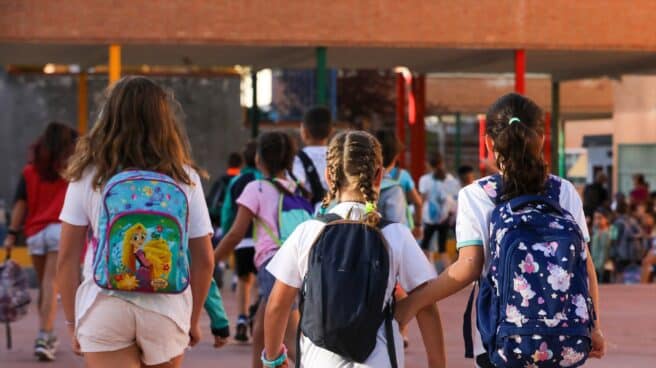

Three girls on arrival at school in Madrid.
According to the High Commissioner for Poverty and Save the Children, Spain is the third country in the European Union with the highest child poverty rate. Every third child suffers from poverty, that is, about 2.2 million, and they will continue to suffer in the next decade if action is not taken. This is exactly what the Economic and Social Council (CES) recalls in its 2022 report, where it insists that this situation has implications for the future employment of this part of the population and, consequently, for their income and the income of the state.
“We are almost the first European country with the highest level of poverty and higher levels of child poverty. And we don’t accept it. And, like any disease, it begins to be cured only when it is recognized. The first article of the Constitution states: Spain is a social and democratic constitutional state. The order is not random. Either the state is social, or it will have problems,” said CES President Anton Kostas at the presentation of the report.
According to the OECD, low investment in childhood from many countries that are members of the club causes us to lose growth by about 1.5 points of GDP every year., which is 2.5 points of GDP in the case of Spain. In other words, based on this forecast, the Spanish economy will grow by about 4% this year, instead of the projected 1.5%, if timely measures were taken in the past to reduce childhood poverty. Costas added that the return on investment in children is higher than investment in infrastructure.
Same country club reportThe cost of a socio-economically disadvantaged childhood or Economic costs of the socio-economic disadvantage of childhoodin the original) estimates the loss of income in Spain due to the dysfunctional childhood of these children at 8% in 2019. It is not only a matter of providing a decent life for the entire population for social justice, it is also an economic loss that is not taken into account when it comes to public policy, the organization says.
The CES report, for its part, confirms that the population at risk of poverty and exclusion has declined over the past few years, but still remains above the EU average. This population also suffered the impact of the pandemic along with inflation, more harmful to those with fewer resources, and soaring interest rates almost at the same time. “This shows the need to once again strengthen protection networks, focusing on supporting the most vulnerable people,” the organization, which represents employers and trade unions, said in a statement.
Here are some data with which he supports his arguments: almost Half of the Spaniards barely make ends meet. 14% who cannot keep their home warm enough in winter. Extreme poverty would increase over the past year, reaching now 577,000 households, or 8% of the total, although it is primarily families headed by single mothers. There are almost 29,000 homeless people, and more than two out of five have been homeless for more than three years. They are mostly middle-aged men, unemployed and without any type of income, but homelessness affects the younger and immigrant population more.
IMV for poverty alleviation
The government’s main anti-poverty tool is the Minimum Living Income (MIA), an allowance to prevent the risk of poverty and social exclusion. It was approved in May 2020 and is available to the most vulnerable people, which is accredited based on net worth and income level. But to date, it has reached 1.8 million people, very far from the 2.3 million that was planned to be reached at the launch of the Executive.
In this sense, CES recognizes that the IMV is prominent among minimum income guarantees in situations of vulnerability, but criticizes this should have started faster and deplores how difficult it is to understand how the recipient can benefit from incentives such as employment, which they assured in the presentation was not understood even by the economists themselves who analyzed the rules.
“Despite significant budgetary efforts, IMV implementation has not progressed as fast as Spain’s poverty risk situation, exacerbated by the high loss of household purchasing power in 2022,” emphasizes the 2022 report. He employment promotionpoints out that its relevance “requires great efforts in terms of transparency and simplification of rules, the complexity of which should not be an obstacle”.
Source: El Independiente